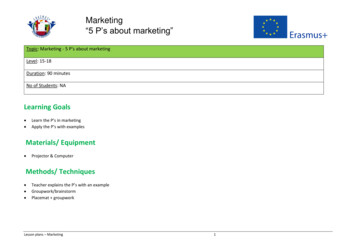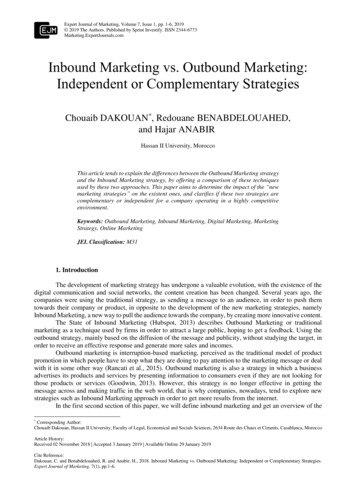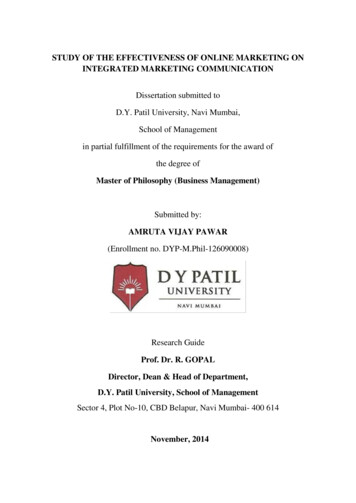
Transcription
International Journal of Business and Social ScienceVol. 6, No. 3; March 2015Colors in Marketing: A Study of Color Associations and Context (in) DependenceMartin Amsteus, PhDSarah Al-ShaabanEmmy WallinSarah SjöqvistSchool of Business and EconomicsLinneaus University351 91 VäxjöSwedenAbstractMirroring an increasing awareness of the importance of colors, today marketing managers are paying increasingattention to the deployment of color in marketing as well as to the applicability of universal color associations.Two colors considered to carry several specific universal associations are blue and black. Consequently, thepurpose of this study is to assess the contextual independence/dependence of consumers’ associations with thecolors blue and black. Associative learning theory was deployed to specify the hypotheses. The hypotheses weretested through a paired sample t-test. The results show that the universal associations with the colors are differentfrom the associations with the colors when they are displayed in a specific context. The implications for furtherresearch and limitations of the study are presented. Managers may want to consider the associations colors havein the specific context rather than relying on universal associations of colors.Keywords: color, associations, context, black, blue1. IntroductionHuman senses are fundamental to the human species. Our sense of smell, taste, touch, hearing, and sight play acritical role in our understanding of the world (Lindstrom, 2005; Myers, 2004). Indeed, it is through our sensesthat we become aware of companies, their offers and their brands (Hultén, Broweus, & Van Dijk, 2009).Mirroring the increased awareness of the significance of human senses, practitioners (Hall, 2013; Wyrley-Birch,2013) (cf. Lee, Heere, & Kyu-soo, 2013) and researchers (Lee et al., 2013; Lindstrom, 2005) are turningincreasing attention to human senses. So-called ‘sensory marketing’ implies pleasing the customer’s senses andinfluencing their perception and behavior (Hinestroza & James, 2014; Krishna, 2012). Among our senses, sighthas been considered the most influential (Hultén et al., 2009; Lee et al., 2013). We learn to interpret visualimpressions very early in life. Most consumers completely trust their sight sense; sight aids them in everythingfrom managing everyday tasks to detecting differences and changes on packages in a store’s interior (Hultén etal., 2009). Moreover, while visual information may be the most influential, research suggests that color is themost influential visual element (Jansson, Marlow, & Bristow, 2004; Kauppinen-Räisänen & Luomala, 2010).Certainly, it is widely recognized how colors can have psychological effects on consumers and different culturaland social meanings through associations (Caivano & López, 2007; da Pos & Green-Armytage, 2007; Hultén,Broweus, & Van Dijk, 2011; Marshall, 2010; Minah, 2008; Pogacar, 2012; Takahashi, 2012). Colors carryspecific meanings and communicate information (Elliot & Maier, 2007). It has been noted by scholars how colorhelps us to create feelings and to activate and stimulate our memory, thought and experiences (Crowley, 1993).Indeed, careful deployment of colors can promote attitudes, feelings and moods and thus differentiate products.Specifically, it has been suggested by scholars that first impressions are derived from color (Chang & Lin, 2010)and that as much as roughly 65-90 percent of our assessment is built on colors only (Singh, 2006).32
ISSN 2219-1933 (Print), 2219-6021 (Online) Center for Promoting Ideas, USAwww.ijbssnet.comIn the fifth century B.C. the Greeks referred to the opposite nature of black/white and light/dark. Later, medievaland Renaissance people related colors to the four elements of nature: earth with white, air with blue, fire withscarlet and water with purple (Mubeen, 2006). Since then, there have been several studies made that indicate thedifferent associations with colors. These color associations have been said to be general (universal) and symbolicfor the different colors (Jacobs, Keown, Worthley, & Ghymn, 1991; Luscher & Scott, 1969; Madden, Hewett, &Roth, 2000; Mubeen, 2006; Rohit & Radhika, 2006). For example, red is said to be associated with warmth, fire,or passion; while green is said to be associated with spring and country (Jacobs et al., 1991). Thus, differentcolors have on the one hand been considered to carry specific symbolic and general (universal) associations.However, on the other hand one can question if these associations apply to the colors independently of thecontexts (cf. Takahashi, 2012). Colors are not perceived independently from objects in the brain. Indeed, it hasbeen argued that companies cannot build their product color choices based on consumers’ favorite colors, whichmay not be what those consumers perceive is suitable for a certain product context. Accordingly, consumers havedifferent color preferences for different product categories, and these preferences are formed through associativelearning (Grossman & Wisenblit, 1999), that is, through cues and outcomes (cf. Morís, Cobos, Luque, & López,2014; Waldmann & Walker, 2005). Based on the associations that consumers have formulated from pastexperiences, they learn color preferences for specific products (Grossman & Wisenblit, 1999).While some scholars contend that consumers’ associations with colors are unchanging and general (universal),others maintain that they differ across a number of variables, including gender, age and culture (Singh, 2006). Towhat degree color associations apply independently of context is an important question. Colors are an integral partof marketing communications, and marketing practitioners use color consultants to help them determine whichcolor or colors most appeal to their customers (Grossman & Wisenblit, 1999; Mubeen, 2006). However, researchon colors in marketing is scarce (Labrecque & Milne, 2012) and the need for more research has been noted(Grossman & Wisenblit, 1999; Krishna, 2012; Singh, 2006). Two colors considered to carry several specific anduniversal associations are blue and black (Babin, Hardesty, & Suter, 2003; Bottomley & Doyle, 2006; Chang &Lin, 2010; Jacobs et al., 1991; Madden et al., 2000; Mubeen, 2006; Singh, 2006). Consequently, the purpose ofthis study is to assess the contextual independence/dependence of consumers’ associations with the colors blueand black2. Theory and Hypotheses2.1 Associative LearningLearning is a relatively permanent change in a person’s behavior and is a result of experiences. Experience doesnot necessarily affect learning directly; indirectly, we can learn by observing events that affect others (Hoover,Giambasita, & Belkin, 2012; Obloj & Sengul, 2012). Associative learning implies any orderly association ofstimuli to create a link between them (Grossman & Wisenblit, 1999). However, there are two basic principles oflearning, operant and classical conditioning (McSweeney & Bierley, 1984).Classical conditioning is a form of learning that is often used to explain the process of associations becauseassociations are not directly observable. Consumers are not born with preferences for different colors; they learnbased on associations that they form through their experience. Consumers can develop preferred colorassociations for a certain product category. This is because they learn, through association, that a certain color orcolors are appropriate for certain product categories (Grossman & Wisenblit, 1999). Specifically, classicalconditioning occurs when a stimulus that naturally elicits a reaction is coupled with a second stimulus that byitself and initially does not elicit such a reaction, but over time, the second stimulus elicits a similar response asthe first as the two become associated (Bierley, McSweeney, & Vannieuwkerk, 1985; McSweeney & Bierley,1984) (cf. Skinner, 1974). It has been noted by scholars how associative learning is a promising area when itcomes to explaining consumers’ responses to product colors (Grossman & Wisenblit, 1999). Indeed, classicalconditioning has been deployed to alter the color preferred on certain products (i.e. Gorn, 1982) (cf. Baeyens,Eelen, Vandenbergh, & G., 1990; Middlestandt, 1990). Color preferences have been altered by pairing specificcolors with, for example, pleasant music. Consumers subjected to pleasant music paired with a specific color laterpreferred products with the same color (Grossman & Wisenblit, 1999).However, within marketing more focus has traditionally been granted to operant conditioning (McSweeney &Bierley, 1984). In operant conditioning, learning takes place as organisms learn to associate behaviors withconsequences. Simplified, the probability for behaviors or responses that are followed by (associated with) a33
International Journal of Business and Social ScienceVol. 6, No. 3; March 2015reinforcer increases (McSweeney &Bierley, 1984; Ruan & Wu, 2013; Shteingart, Neiman, & Loewenstein, 2013)(cf. Skinner, 1974). Put differently, our memory consists of information, but it also consists of previousexperiences of something negative or positive (reinforcement) (Repkina, 2011; Sereda, 2011). Everything peoplelearn can be described as the development of patterns, and every individual has his or her own set of patterns andassociations that in turn will help make sense of the world. The patterns in consumers’ brains are a result of thediffering representations and relationships with the world (Grossman & Wisenblit, 1999). Associations betweentwo things develop gradually, and repetition is an important factor when forming them. Accordingly, it is easier toform associations between items that have already been presented together previous times (Rock, 1957). That is,we look back at our memories and experiences in terms of positive and negative reinforcement that we haveexperienced. The association may take the form of a connection between such memories and positive or negativereinforcement.Associative learning can be deployed as a lens through which human response to colors can be explained(Grossman & Wisenblit, 1999). Indeed, it has been suggested that color associations have been formed early inthe history of man: dark blue was associated with night and therefore being passive; yellow with sunlight andarousal; red with attack and conquest; and green with self-preservation (Luscher & Scott, 1969) (cf. Marshall,2010). Associative learning has also been deployed to explain how certain colors come to have certain meaningsin different cultures (Grossman & Wisenblit, 1999).2.2 Color in MarketingColors connote specific meanings and communicate information beyond simple aesthetic appeal (Caivano &López, 2007; da Pos & Green-Armytage, 2007; Hultén et al., 2011; Marshall, 2010; Minah, 2008; Pogacar, 2012;Takahashi, 2012). Consumers have different color preferences for different product categories, and thesepreferences are formed through associative learning. As mentioned, consumers’ favorite colors might not be whatthey believe is suitable for a certain product context. That is, colors are not perceived independently from context,and accordingly, companies cannot build their product color choice based on consumers’ favorite colors(Grossman & Wisenblit, 1999).Certainly, colors on products may attract attention and convey information; in other words, color is an influentialdesign element (Jansson et al., 2004; Kauppinen-Räisänen & Luomala, 2010). The colors companies choose ontheir brands contribute to their brands standing out from other brands (Caivano & López, 2007). Consumers usecolor to search for and identify brands (Kauppinen-Räisänen & Luomala, 2010). That is, color is valuable in logodesign and brand personality (Caivano & López, 2007; Labrecque & Milne, 2012). “Indeed, color can be animportant, controllable marketing variable for managing image standardization because a product’s color canfunction not only as an immediate identifier of its brand but also its quality and price” (Singh, 2006, p. 787).Thus, on the one hand the right color can promote recognition of, for example, logotypes and products (Hultén etal., 2011), and it can maintain consumer’s attention (Kauppinen-Räisänen & Luomala, 2010). On the other hand,the wrong color choice may hamper any communication between a company and its target market. Choosing thewrong color can hurt brand awareness and any attempt to build a sustainable brand image (Hultén et al., 2011).The importance of choosing appropriate colors may be especially salient within the store environment as colorscan affect perceptions of the merchandise (cf. Crowley, 1993).The focus of the present study is the colors blue and black as these are considered to carry several specificuniversal associations (cf. Babin et al., 2003; Bottomley & Doyle, 2006; Chang & Lin, 2010; Jacobs et al., 1991;Madden et al., 2000; Mubeen, 2006; Singh, 2006). In addition, both blue and black have been ascribed bothcommon and contradictory associations: Black is said to be associated with dirt and grime. Blue, in contrast, isassociated with hygiene and cleanliness (Bottomley & Doyle, 2006; Chang & Lin, 2010; Singh, 2006). At thesame time, both colors are associated with trustworthiness (Jacobs et al., 1991). Moreover, the associations withthese two colors are generally considered stable across cultures (Bottomley & Doyle, 2006) (cf. Babin et al.,2003; Madden et al., 2000; Singh, 2006); i.e., they are considered to connote the same associations acrosscultures.2.3 The Color BlueSeveral authors mark that blue is a generally calming and peaceful color (Babin et al., 2003; Bottomley & Doyle,2006; Chang & Lin, 2010; Kauppinen-Räisänen & Luomala, 2010; Madden et al., 2000; Singh, 2006). The colorblue is also generally associated with high quality, attractiveness, freshness, neutrality, effectiveness, and34
ISSN 2219-1933 (Print), 2219-6021 (Online) Center for Promoting Ideas, USAwww.ijbssnet.comtrustworthiness (
color to search for and identify brands (Kauppinen-Räisänen & Luomala, 2010). That is, color is valuable in logo design and brand personality (Caivano & López, 2007; Labrecque & Milne, 2012). “Indeed, color can be an important, controllable marketing variable for managing image standardization because a product’s color can function not only as an immediate identifier of its brand but .











